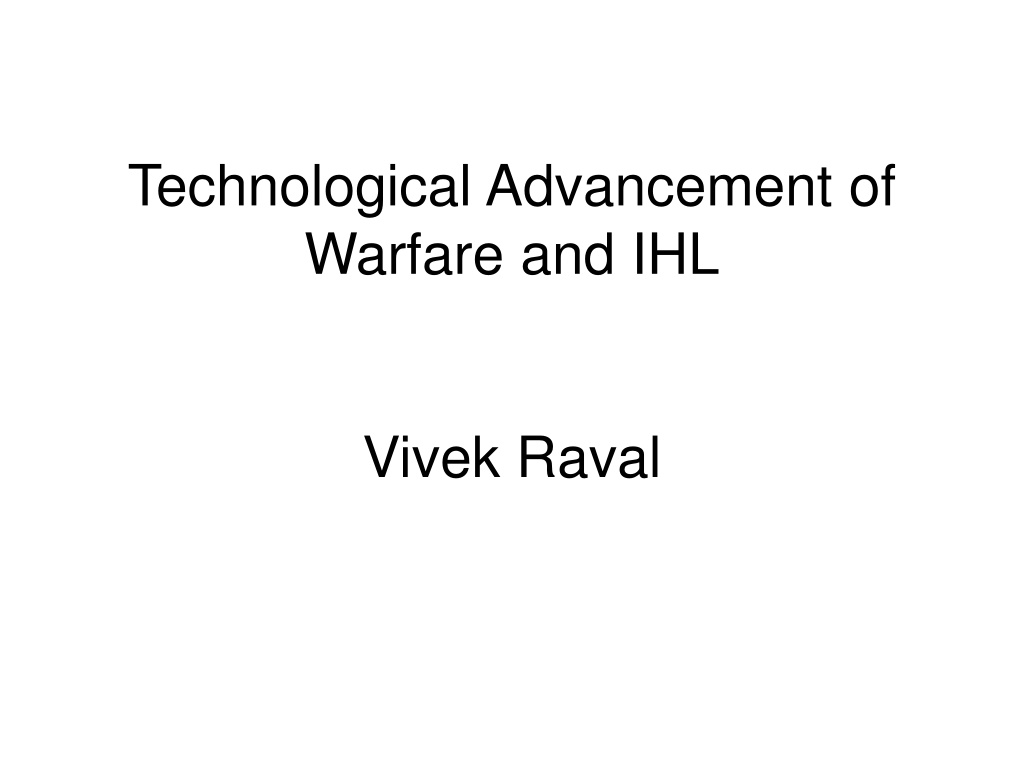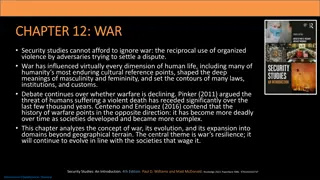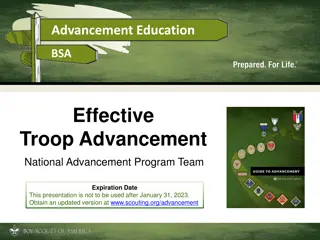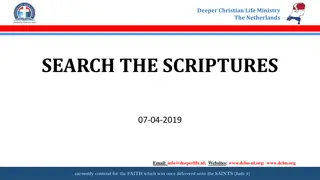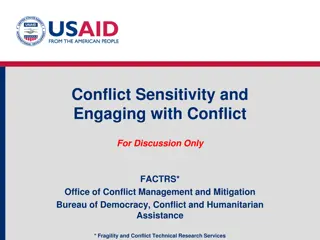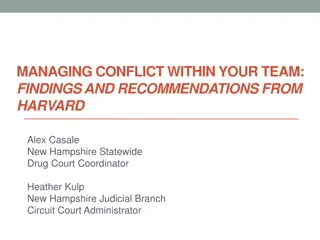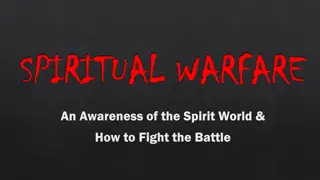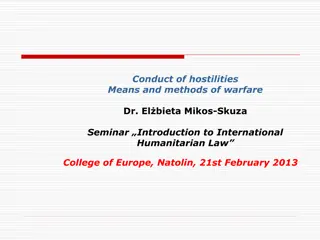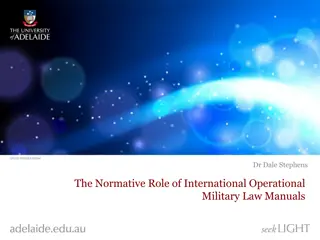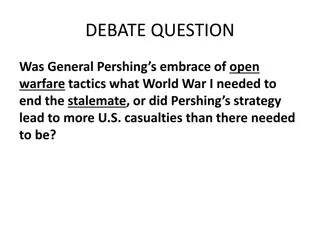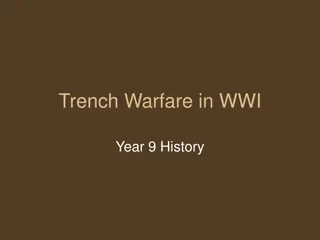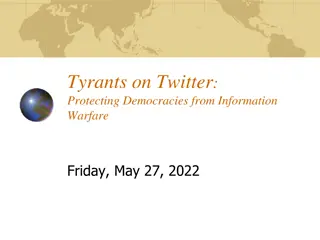Technological Advancement of Warfare and IHL - Changing Dynamics of Conflict in the 21st Century
The world is witnessing a transformation in conflicts due to technological advancements, globalization, and information warfare. From historical changes in warfare to the current impact of internet disruptions and global connectivity, the nature of conflicts and ways of fighting have evolved. This evolution raises questions about solving conflicts peacefully, the role of information warfare, and the escalating civilian deaths in interstate conflicts, indicating the changing landscape of warfare and international relations.
Download Presentation

Please find below an Image/Link to download the presentation.
The content on the website is provided AS IS for your information and personal use only. It may not be sold, licensed, or shared on other websites without obtaining consent from the author. Download presentation by click this link. If you encounter any issues during the download, it is possible that the publisher has removed the file from their server.
E N D
Presentation Transcript
Technological Advancement of Warfare and IHL Vivek Raval
Introducing the 21stCentury To begin with...what kind of world do we live in? February 2003 three hackers disrupted the US logistics planning for the US operations in the Persian Gulf Internet is used by 1.7-2 billion people 50% of world population lives in the cities Globalisation is on the rise over 550 million people relocated across borders annually, over 6 million people fly daily India+China = 35% and the US+EU = 60% of the world economy (there are 192 United Nations member states!); of the 100 largest economies in the world only 47 are states, the rest are multinational corporations
The world is rapidly becoming a global village connected at various levels by new technologies, integrating economy and societies Does it mean that we solve our conflicts differently? Have we become more peaceful, do we fight differently? Are we witnessing changing conflicts in a changing world? Has information warfare gained a special role in these conflicts or has it become a way of fighting a conflict in its own right?
Conflicts 1946-2006 Source: Human Security Brief 2007, Vancouver: Simon Fraser University
Civilian Deaths: Interstate Conflict Source: Human Security Brief 2007, Vancouver: Simon Fraser University
Introduction:changes in warfare and in constitutional order Innovations Princely state 1494-1572 1567-1651 Kingly state Territorial state 1649-1789 State-nation Nation-state 1776-1870 1861-1991 -Consistent finance -Permanent government -Absolutism -Trade control -Aristocratic leadership -Nationalism -Nationalism Constitutional -Sectarianism -Imperialism -Ideology -Use of mercenaries -More firearms -Professional armies -Mass conscription and mass armies -Nuclear weapons Warfare -Mobile artillery -Siege warfare -Limited wars -Rapid computation -Decisive battles -Fortification -Standing armies -International communica- tions Source: Bobbitt, P. (2002) The Shield of Achilles , London: Penguin Books, pp.346-347
Introduction:basic terms Information warfare/operations (IW/IO) is... ...the integrated employment of (1) the core capabilities of electronic warfare, (2) computer network operations, (3) psychological operations, (4) military deception, and (5) operations security, in concert with specified supporting and related capabilities, to influence, disrupt, corrupt or usurp adversarial human and automated decision-making while protecting our own
The evolution of information society seems to be transforming war into a communication campaign of violent and destructive messages Information society (i.e. growing access to technologies that could be used for destructive purposes as well as growing vulnerability of society) enables smaller groups to challenge states Does it all mean fading of nation-state and emerging of a new constitutional order (market state P.Bobbitt) remains to be seen and will be discussed during the course
MILITARY TECHNOLOGIES Intelligence and counter- intelligence security methods State border protection systems Enemy detection systems Anti-missile shield Psychotropic weapons Non-lethal weapons Soldier equipage Firearms Space weaponry technologies Mines and demining technologies Electromagnetic pulse weapons Amours and their technologies Laser weapons Plasma weapons Tectonic weapon Cybernetic technologies in an army Communications and infor- mation encryption in warfare Military medicine Anti radar materials Energy sources in an army Future weapons Military positioning and navigation systems Military positioning and navigation systems Military electronics Weapon manufacturing technologies Military training facilities Reactive materials in warfare
BATTLEFIELD RECONNAISSANCE The aim: the exploration of the future battlefield; receiving the information on the enemy's force structure, its location, and potential. Means: unmanned air vehicles; radars; sonars; space satellites.
MILITARY ROBOTS Robots play a constantly increasing role in warfare they are unmanned aerial reconnaissance and combat vehicles, demining robots, (e.g. SPIKER , RASP ), universal military robots capable of substituting soldiers ( Warrior 700 ), robots making corridors in mine fields etc. Nevertheless, the ethical issues on the applications of robots in warfare and the problems of the latters consistency with Geneva conventions appear already.
FUTURE ARMAMENT PROJECTS Futuristic armament projects: Godrods ; Metalstorm ; Powerful electromagnetic guns; High power chemical laser; Cavitation torpedo. This was only a few examples of futuristic projects. Some of them will be implemented and others probably not, but in general their ideas are actual not only for warfare. We would like to believe that such technologies will never be used according to their direct destination, but will be applied by mankind for peaceful purposes.
A classification of systems Controlled Supervised Automated Autonomous
Controlled A system that requires activation, direction and manipulation by a person ("man in the loop").
Supervised A system is essentially an automated weapon or that has some degree of self-function but this function is permanently supervised by a human operator. Operator supervises, does not initiate every function but may, at any time, block or take over the automated function of the system. ("man in the loop").
Automated A system functions in an independent manner and does not require the intervention of a human operative for activation, direction, manipulation, nor for any other function. System is pre-programmed in a specific manner and cannot adapt its function outside those parameters. "Fire-and-forget" or "target-and-forget systems.
Autonomous An automated weapon that can adapt its function to changing circumstances. This is the world of artificial intelligence.
IHL does NOT prohibit technological developments for war fighting BUT these developments MUST be measured and assessed against existing legal norms.
Rule of Distinction Obligation to distinguish at all times: civilians and other protected persons from combatants civilian objects from military objectives
Indiscriminate attacks are prohibited attacks not directed at a specific military objective means and methods of warfare that cannot be directed at a a specific military objective
Proportionality in attack It is prohibited to launch an attack which may be expected to cause incidental loss to civilian life, injury to civilians, damage to civilian objects which would be excessive to the military advantage anticipated.
Propositions Current IHL covers controlled systems Current law covers supervised systems Current law should cover automatic systems Current law may not be enough for autonomous systems
Issues and concerns Autonomy: the absence of a "man in the loop" and related issues of target identification Application of IHL rules distinction, proportionality and precautions. Is it feasible to program IHL compliance? Where would liability/responsibility lie for failure or violations?
Other issues Cyber warfare Deleted uranium Incapacitating chemical agents The weaponization of biotechnology
